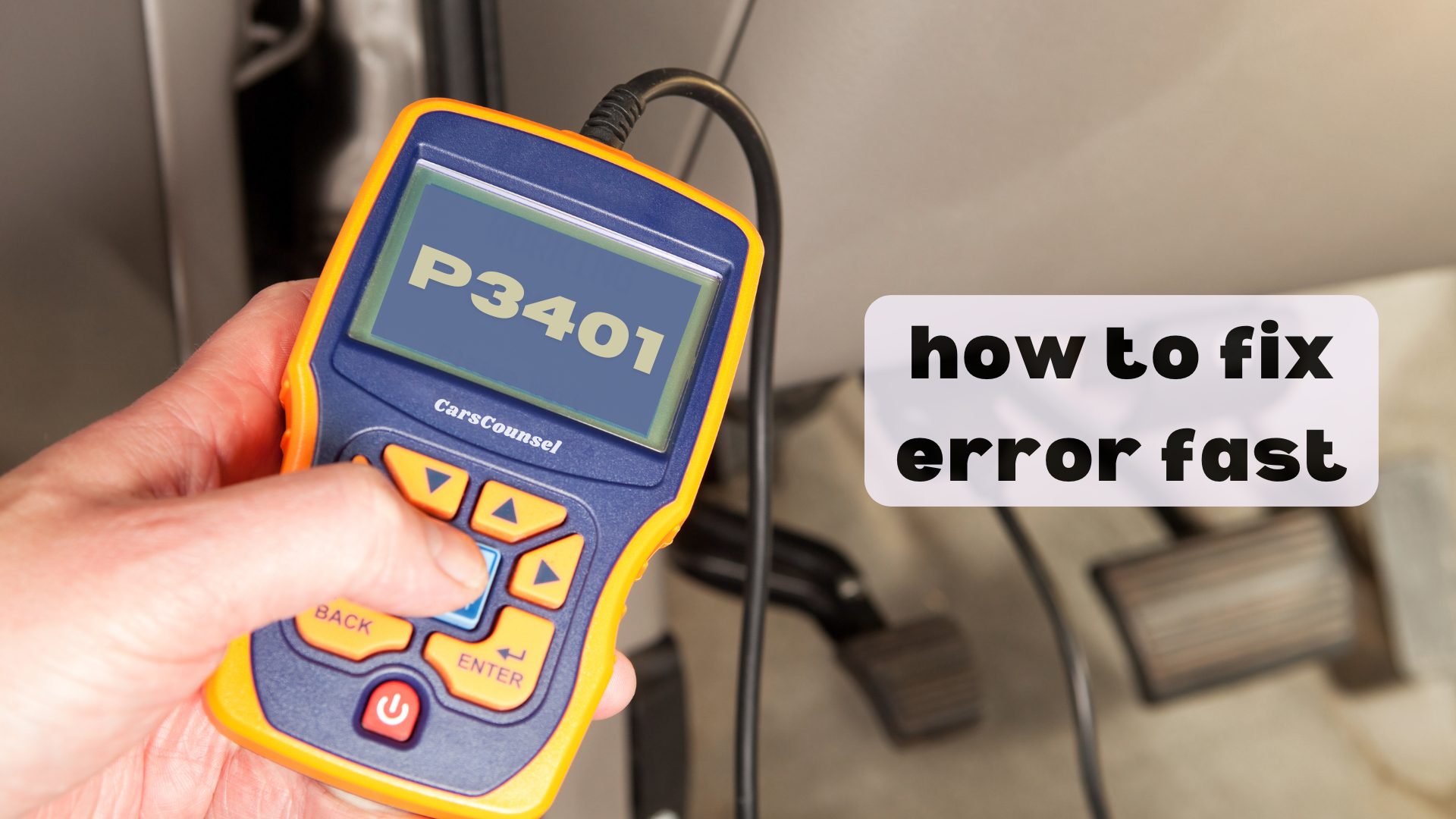Dealing with a P3401 code can be tricky, but you can fix it quickly with the right steps.
First, get an OBD-II scanner to confirm the error and check for any related error codes.
Look at the wiring and connectors to make sure nothing is damaged and all connections are tight.
Test the camshaft position sensor and the VVT actuator to see if they’re working properly.
If low oil pressure is causing the problem, make sure your engine oil levels and quality are good.
After making any repairs, clear the diagnostic codes and keep an eye on the system.

Need detailed steps for each part?
Quick Navigation
Key Takeaways
- Check the engine oil level and quality, making sure it’s clean and has the right thickness.
- Look at the camshaft position sensors and VVT actuators, and fix or replace them if they are broken.
- Check all the wiring and electrical connections for any damage or rust, and secure them properly.
- Use an OBD-II scanner to get specific trouble codes and related information.
What Is the P3401 Code?
The P3401 code is a diagnostic trouble code (DTC) that tells you there’s a problem with your engine’s cylinder deactivation system and Variable Valve Timing (VVT).
These systems help make your engine more efficient and powerful. When there’s an issue, your engine can’t turn off certain cylinders properly, which can lead to worse fuel efficiency and reduced engine power.
It’s important to fix this issue quickly to keep your engine running well and avoid more serious damage. Regular maintenance and prompt attention to this code can help ensure your engine stays in good shape.
Cylinder Deactivation System
Cylinder deactivation systems help save fuel by temporarily turning off some cylinders when you don’t need full engine power.
By using only the necessary cylinders during light driving, you use fuel more efficiently and produce fewer emissions.
This system uses special parts to control the oil flow to certain cylinders, turning them off when less power is needed.
It’s a complex technology that needs to work just right. If it breaks down, you might notice engine misfires, rough idling, or slower acceleration.
Regular check-ups and repairs ensure the system works well, keeping your engine running smoothly and saving fuel.
Variable Valve Timing (VVT)
Variable Valve Timing (VVT) boosts engine performance by changing the timing of the intake and exhaust valves according to driving conditions. With VVT, you get better fuel efficiency, more power, and lower emissions.
However, if you encounter issues like the P3401 code, it’s crucial to troubleshoot VVT. Start by checking the VVT actuator and related sensors for any wear or damage. Make sure the oil level is right and the oil is clean, as this is essential for VVT to work properly.
Also, inspect the wiring connections for any problems. If needed, replace the VVT actuator or the camshaft position sensor. Proper VVT troubleshooting ensures your engine runs at its best and helps avoid further issues related to the P3401 code.
Common Causes of P3401
[Speak in plain English]
If you see the P3401 code, it usually means there’s a problem with the cylinder deactivation system or the camshaft position sensor. These issues can mess with how well your engine runs. Other common reasons for this code include low engine oil pressure and problems with the timing chain or belt. Electrical problems like damaged wires or bad connections can also cause this code to pop up.
| Common Cause | Impact on Engine |
|---|---|
| Faulty cylinder deactivation | Poor cylinder performance |
| Bad camshaft sensor | Lower engine efficiency |
| Low engine oil pressure | Poor cylinder deactivation |
| Timing chain/belt problems | Misaligned camshaft |
| Damaged wiring/poor connections | Electrical issues |
It’s important to find and fix these problems quickly to keep your engine running well and to avoid more serious damage.
Faulty Sensors and Actuators
When you see the P3401 code, it’s often because of bad sensors and actuators messing up how the engine’s cylinder deactivation and VVT systems work.
Here’s how to fix it:
- Replace Sensors: Look for any bad camshaft position sensors that mess with the timing and swap them out.
- Test Actuators: Make sure the VVT actuators are working right by testing them.
- Check Wiring: Inspect the wires and connectors for any damage or loose connections that could cause problems.
- Clean Components: Clean or replace any dirty lifters affecting the cylinder deactivation system.
Taking care of these issues can get your engine running smoothly again and clear the P3401 code. Always use good parts and follow the manufacturer’s instructions for the best results.
Engine Oil Pressure Issues
After fixing any faulty sensors and actuators, it’s crucial to check the engine oil pressure. Low oil pressure can really mess up the cylinder deactivation and Variable Valve Timing (VVT) systems, causing the P3401 code.
Start by checking the oil level and quality. If the oil is low or in bad shape, it can mess with engine lubrication. Make sure you’re using the right oil thickness as specified by the manufacturer; the wrong thickness can affect oil flow and pressure.
Do an oil pressure test to ensure it matches the required specifications. If the oil pressure is too low, check the oil pump and related parts.
Regular oil changes and using the correct oil thickness are key to keeping your engine well-lubricated and avoiding P3401 code problems.
Symptoms of P3401 Code
If you’re dealing with a P3401 code, you might notice a few things going wrong with your car, like engine misfires, rough idling, and slower acceleration. These problems can mess up how your engine runs and cause you to use more gas. Keep an eye out for these signs:
- Engine Misfires: Your engine might stumble or hesitate, making the ride less smooth.
- Rough Idling: The engine could shake or vibrate oddly when you’re stopped.
- Decreased Acceleration: Your car might feel sluggish when you try to speed up.
- Poor Fuel Economy: You’ll probably use more gas because the engine isn’t running efficiently.
These symptoms mean that your engine’s cylinder deactivation system isn’t working right, which can hurt your car’s performance and fuel efficiency.
Fixing these issues quickly can help you avoid bigger problems down the road.
Diagnosing the P3401 Code
To diagnose the P3401 code, start by using an OBD-II scanner to get the specific code and any related codes from the car’s computer system.
Next, use diagnostic tools to check how the engine is running. Pay special attention to the cylinder deactivation system and the Variable Valve Timing (VVT) system.
Make sure to check the wiring and connectors, as electrical problems can cause the P3401 code.
Run cylinder balance and compression tests to find any misfiring or problematic cylinders.
Also, check the oil level and quality, since low oil pressure can affect both systems.
Visual Inspection Steps
Start by carefully looking at the wiring and connectors for the cylinder deactivation and VVT systems to check for any damage or corrosion. Watch for frayed wires, loose connections, or anything that might interfere with their operation.
Follow these steps to ensure everything is aligned and functioning well:
- Check wiring harnesses: Make sure they’re in good shape and firmly connected.
- Inspect connectors: Check for any corrosion or loose pins that might stop electricity from flowing properly.
- Look at solenoids: Ensure they’re clean and free from oil or debris that could block them.
- Check camshaft sensors: Make sure they’re correctly positioned and not damaged.
A detailed visual inspection can help you quickly find problems and avoid bigger engine issues.
Repair and Prevention Tips
Fixing the P3401 code involves a few key steps to ensure your car’s engine runs smoothly.
First, check for and fix any damaged wiring or bad electrical connections. You might need to replace some parts, like the camshaft position sensor or any faulty actuators. It’s also a good idea to clean or replace lifters and the VVT actuator to keep the engine’s valves working well.
For ongoing maintenance, regularly check and change the engine oil to keep everything lubricated. Follow the manufacturer’s maintenance schedule to avoid problems.
After making repairs, use diagnostic tools to clear the code. By following these steps, you can help prevent the P3401 code from popping up again and keep your engine running at its best.
More OBD-II Codes
Frequently Asked Questions
Can Driving With a P3401 Code Cause Long-Term Engine Damage?
Driving with a P3401 code can damage your engine over time. You might notice your engine not running as well and using more oil. Fix the problem right away to avoid more damage and keep your engine running smoothly.
How Much Does It Cost to Fix a P3401 Code?
Fixing a P3401 code can cost anywhere from $200 to $1,000, depending on the parts required. Additionally, you might have to pay $50 to $150 for diagnostic fees. These diagnostics help identify the exact problem and guide the needed repairs.
Is P3401 Covered Under Vehicle Warranty?
Ever wondered if P3401 is covered under your vehicle warranty? The details can be different, so look at your warranty limits. Usually, powertrain warranties might cover it, but always check with your dealer or your warranty papers to be sure.
Can a DIYER Fix the P3401 Code, or Is Professional Help Needed?
You can try fixing it yourself if you have the right tools, but getting a professional is a good idea for an accurate diagnosis and repair. Complicated problems like bad camshaft position sensors or VVT actuators usually need expert skills and equipment.
How Long Does It Take to Diagnose and Repair a P3401 Code?
Figuring out what’s causing a P3401 code usually takes about 1-2 hours, depending on how experienced you are. Fixing the problem can take around 3-5 hours. This depends on how easy it is to get the parts you need and how complicated the issues are.
Conclusion
You can do this! Fixing the P3401 code might seem challenging, but follow these steps, and you’ll get it done quickly.
First, grab an OBD-II scanner and check every wire, sensor, and actuator carefully.
Make sure to use high-quality oil for your engine.
Clear the error codes, and your vehicle will run smoothly again.
Fixing this error will feel amazing!

